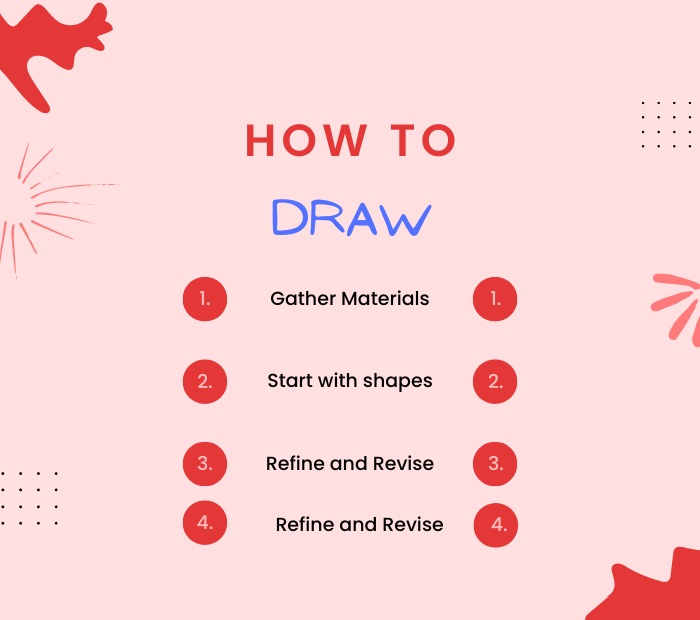How to draw
How to draw is the step-by-step process for drawing that will help you start your drawing work. Remember that everyone has their own unique style and approach to drawing, so don’t be too hard on yourself if your drawings don’t look exactly like you want them to at first. Keep practicing and experimenting, and have fun with the process!
- Gather your materials: You will need a pencil, eraser, and paper.
- Start with basic shapes: Begin by sketching out the basic shapes of the subject you want to draw. This will help you get the proportions and placement right.
- Add details: Once you have the basic shapes in place, you can start adding more details. Focus on one part of the subject at a time, and work on getting the details as accurate as possible.
- Shade and texture: Once you have the outlines and details done, you can add shading and texture to give your drawing depth and dimension. Use a range of values from light to dark to create the illusion of shadows and highlights.
- Refine and revise: Take a step back and look at your drawing as a whole. Make any necessary revisions to the proportions or details, and refine your shading and texture as needed.
- Practice, practice, practice: Drawing is a skill that takes time and practice to develop. Keep practicing and experimenting with different techniques and styles to improve your skills.
Remember to be patient and persistent with your drawing practice, and don’t be afraid to make mistakes. Every drawing is a learning opportunity.
Read More: How to Make Pancakes
Here are some practical ideas to help you get started with drawing:
- Start with simple shapes: Begin by practicing drawing simple shapes, such as circles, squares, and triangles. This will help you get comfortable with the basics of drawing and develop your hand-eye coordination.
- Copy from photos or other art: A good way to practice drawing is by copying from photos or other art. Find an image you like and try to recreate it as accurately as possible. This will help you develop your skills in terms of proportions, shading, and texture.
- Draw from life: Another way to practice drawing is by drawing from life. Find objects or scenes around you that inspire you, and draw them as accurately as possible. This will help you develop your observation skills and train your eye to see details and nuances.
- Experiment with different mediums: Try out different drawing mediums, such as pencils, pens, charcoal, or pastels. Each medium has its own unique properties and can create different effects. Experimenting with different mediums will help you discover what works best for you and your style.
- Practice regularly: Drawing is a skill that requires practice and dedication. Set aside time each day or week to practice drawing, even if it’s just for a few minutes. The more you practice, the more you will improve.
Remember that everyone has their own unique style and approach to drawing, so don’t be too hard on yourself if your drawings don’t look exactly like you want them to at first. Keep practicing and experimenting, and have fun with the process!
Why the learning for drawing is important
Learning how to draw can be important for several reasons:
- Creativity and self-expression: Drawing is a form of creative expression that can help you tap into your imagination and convey your thoughts and emotions in a visual way.
- Visual communication: Drawing can also be an effective way to communicate ideas and concepts visually. This is especially useful in fields like architecture, engineering, and design, where visual communication is crucial.
- Observation and perception: Drawing can help you develop your observation skills and train your eye to see details and nuances that you may have overlooked before. This can be useful in many aspects of life, from appreciating art to problem-solving and decision-making.
- Relaxation and stress relief: Drawing can be a relaxing and meditative activity that can help reduce stress and anxiety. It allows you to focus on the present moment and express yourself creatively without any pressure or expectations.
- Career opportunities: If you have a talent for drawing, it can open up many career opportunities in fields such as illustration, graphic design, animation, and more.
Overall, learning how to draw can have many benefits, both personal and professional. It can help you develop new skills, express yourself creatively, and see the world in a new way.
Written by
Email: [email protected]
How to draw

